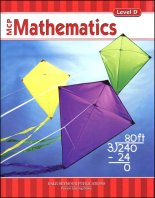Modern Curriculum Press (MCP) Mathematics, Levels K, and A-F, for grades K through 6 is one of the easiest-to-use math resources for the elementary grades. The student book comes in worktext format so lesson presentation and work pages are combined in one place for the most part.
The teacher’s edition is very useful, even though children can do much of their work independently. First of all the book itself has a plastic spiral binding so the book will lie flat when it is open. It features reduced student pages with answers overprinted so it is easy to check your child’s work. Around the outside of the reproduced pages are lesson objectives, items you might use for a hands-on presentation for some lessons, mental math activities for practice, and very brief instructions for lesson presentation. The teacher’s manual also points out common errors as well as strategies to avoid them. Everything you might need is visible on a two-page spread. It is easy to pick out what you might want to use so lesson preparation time is minimal.
Instruction within student books includes explanations of concepts, usually with visual diagrams and sometimes with suggestions for using hands-on materials. Base Ten Blocks ® are pictured from time to time, so they might be a good choice for math manipulatives to use alongside this series. Word problems combine with conceptual presentations to help children develop mathematical thinking skills.
Many parents find that their children can work through lessons without parental lesson presentation, so it is tempting to use this series for independent study, skipping the interactive parts of the lessons presented from the teacher's edition. If you do this, students miss out on mental math exercises and other activities that significantly enrich the course. While students might be able to complete most of the lessons on their own, I encourage you to take the time to use other parts of the lesson presentations in the teacher's edition that you find helpful.
A chapter test is included in the student book at the end of each chapter. Chapter tests focus on concepts taught in only that chapter. Following each chapter test is a cumulative review with problems from many of the previous chapters. Reproducible alternate tests for each chapter are at the back of the teacher's edition in case you need to retest your child.
A weakness of this series is that it deals with only one subject per lesson and sometimes only one topic like multiplication per chapter (containing maybe seven or eight lessons). Students review previously learned concepts at infrequent intervals on the cumulative assessments at the end of each chapter. This lack of continual review does not usually present a problem up through third grade, but by fourth grade, you might need to either supplement with other means of review or do as one mom suggested—skip occasional problems in each lesson, then come back and use those for review.
This series moves at a slower pace than in programs such as Horizons Math and Rod and Staff's Arithmetic series. However, it does a good job on concept development through lesson presentations and word problems that are often quite challenging. Level K for kindergarten is very easy and not really necessary. I would begin with Level A (first grade) and perhaps use the series at a faster rate than is suggested by the publisher. You might also use supplemental resources to provide more frequent practice on a variety of math skills, especially at the fourth-grade level and above.
This series has been updated a number of times over many years, but it has not changed significantly. Some minor changes have been made in the scope and sequence over the last few decades. For example, calculator usage was gradually introduced at various grade levels and expanded coverage of geometry has been added in keeping with increased emphasis on introducing geometry in the elementary grades. Unlike math series from most major publishers, this series was not rewritten to align with the NCTM standards or the Common Core standards, a factor that might be considered either positive and negative. With its narrower focus on the most important math concepts and skills, it does a better job of teaching foundational math skills than do many resources that try to cover “everything.” However, the slower progression might put children behind their age-mates in covering even the basics like multiplication and division.
Homeschool packages include both the student worktext and the teacher's edition.




















